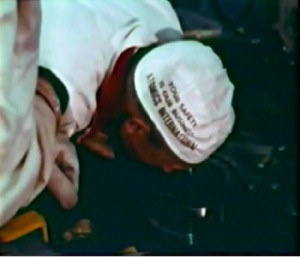
(Bien conducted this interview as part of our co-bylined August 24, 2009 Miller-McCune article “50 Years After America’s Worst Nuclear Meltdown – Human error helped worsen a nuclear meltdown just outside Los Angeles, and now human inertia has stymied the radioactive cleanup for half a century.”)
Joan Trossman Bien: How does Boeing characterize the events of July 12-26, 1959, regarding the Sodium Reactor Experiment in Area IV?
Boeing: The Sodium Reactor Experiment was operated by the U.S. Atomic Energy Commission, the predecessor to today’s U.S. Department of Energy. As such, the DOE is the lead agency in responding to media inquiries about the SRE. Please contact Bill Taylor, Department of Energy, for questions related to the Sodium Reactor Experiment.
Did contamination problems concern Boeing when it bought the property in 1996?
In 1996, the acquisition of Rockwell’s aerospace and defense businesses accelerated Boeing’s 20-year vision, which called for the company to be a fully integrated aerospace company designing, producing and supporting commercial airplanes, defense systems, and defense and civil space systems. As such, the acquisition of Rockwell and Rocketdyne aligned with Boeing’s business strategy.
When Pratt-Whitney bought Rocketdyne in 2006, why did it not buy the above-referenced lab?
Please contact Bryan Kidder, Pratt & Whitney Rocketdyne, for questions related to Pratt & Whitney.
What has been done (up to now) to clean up the contamination from the 1959 event?
Please contact Bill Taylor, Department of Energy, for questions related to remediation in Area IV.
Since acquiring our site in 1996, Boeing has made significant progress in our clean-up efforts, and we are moving toward our goal of preserving Santa Susana as open space. This includes removing 50,000 cubic yards of contaminated soil and debris, analyzing more than 10,000 soil and groundwater samples for numerous chemical constituents, installing Best Management Practices at outfall locations around the site and installing more than 400 monitoring wells on and off site.
Is Boeing going to keep its promise to the U.S. Congress and to Senator Barbara Boxer by following the law of SB-990?
Are you referring to a statement that the DOE made to Senator Boxer? Please contact Bill Taylor, Department of Energy.
Although SB-990 was signed into law more than a year and a half ago, why has Boeing still not agreed in writing to follow SB-990? What has been caused the delay? Are the agricultural standards too strict since the land may become open space or a park? If Boeing cleans up the property to RA standards, would it consider developing the site since it would be so clean?
Boeing and its federal partners have been working for the last eighteen months to amend the existing Consent Order to incorporate the terms of Senate Bill 990 and establish a clear process for completing the investigation and cleanup in a timely manner. We have made a lot of progress toward amending the Consent Order and are optimistic that a consensual agreement can be reached that allows us to proceed with an effective cleanup. The amended order will replace the August 2007 Consent Order between Boeing, its federal partners and the state. While we’ve been in discussions with the state, we’ve also continued previously approved clean-up efforts at the site (and the progress we’ve made to date is listed above). The state has acknowledged Boeing and its federal parties for having “met all their obligations” under the existing order.
We remain committed to the vision we share with so many of our neighbors and others in the local community around Santa Susana – an effective cleanup that protects human health and the environment. Home to rare and protected species, magnificent riparian oak woodlands and other biota, Santa Susana’s biological value is unmistakable. Our intent is to donate Santa Susana as protected open space for the benefit of the community. According to a South Coast Wildlands report, Santa Susana sits within a rare and vital wildlife corridor that connects the Sierra Madres to the Santa Monica Mountains and the Pacific Ocean. Boeing will legally restrict future land use of our site to open space.
Is Boeing going to sue the State of California over SB-990, as Norm Riley said you might?
We are optimistic that a consensual agreement can be reached that allows us to proceed with an effective cleanup in a timely manner.
24 Years of Award-Winning SSFL/Rocketdyne Reporting
June 1998 – June 2022












Recent Comments